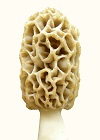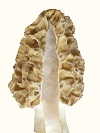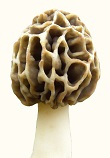 |
|
Research Photo Pages
|
Taxonomists look for groups with similar characteristics, but they don't exist for morels. There are some repeated appearances in shape, but many other variations are included such as color, texture of ridges and tissue thickness. Those differences are due to phenotypic variations, as shown here on the Phenotype Photo Page. Morels are also highly variable in genotypes due to much difficulty in getting spores out, which causes them to produce localized variations. In stressful environments, such as the upper plains of the U.S., recognizable genotypic differences are observed about every 100 miles of space. Where conditions are more favorable, fewer variations are visible for both genotypes and phenotypes. However, the phenotypic variation is always extreme for morels due to an extremely large number of genes being variable as allotypes. One reason why morel taxonomists are thrown into confusion is because they assume the evolutionary history of morels goes back more than a hundred million years. Such a long history would produce highly stabilized characteristics. The only mushrooms that go back farther than the modern biological era of the past 66 million years are the puffball and closely related bolete of 300 million years ago. They have very distinct, stabilized and refined characteristics due to their evolutionary age. The mainline puffball has four phenotypes which emerge in sequence. Over time, only a few of the most necessary phenotypes are preserved.
How could they miss the extreme phenotypic variation? One reason is because the extremes are most visible under the harshest conditions, such as the hot and dry summers of the upper plains of the U.S. Under more favorable conditions, the variations are less extreme and visible. The extreme phenotypic variations have been showing up in molecular studies of both enzymes and DNA; but morel scientists did not know how to interpret the results. There were three to five variants (allotypes) found for each enzyme of the TCA cycle. The scientists were confused by the results and did not interpret it in terms of phenotypic variations. That's surprising; but it shows that scientists at the universities are so absorbed in technical details that they don't spend time evaluating surrounding subjects. In part, that situation results from endless distractions from nonscientific demands including teaching at the universities. The time scale of 129-154 million years of evolutionary age for morels is also difficult to imagine. In part, the methodology of phylogenetic studies is extremely unreliable for taxonomy, because too small of a parameter base is used. Correlations are sought not realizing how unreliable correlations are in the huge variations of technical details of biology. It takes physiological studies to understand morels. Morels still have the physiology of yeasts, since they evolved from a single-celled, filamentous yeast starting 50 thousand years ago and emerging from the ground 20 thousand years ago. Like yeasts, morels excrete acetic acid to kill bacteria and feed upon them. Excreting acid is extremely problematic; and it is the main reason why morels are impossible to grow in a practical manner under artificial conditions. With attempts to produce high density growth, the acid accumulates and kills the mycelium. Under natural conditions, the mycelium spreads widely through sandy soil (or mountain humous) which dilutes the acid. Then the mycelium produces the maximum amount of acid that the mycelium will tolerate, while it won't tolerate the increase in acid under conditions of high density growth. The morphology of morels is highly variable, because change in morphology is nothing more than counting cells in each direction. But physiology is highly resistant to change, because the internal cell structure cannot be altered without drastic results. Cells are like thousands of assembly lines near each other. Each reactant must move from one enzyme to another without diffusing into the cytoplasm. Any disturbance in positions is catastrophic, which prevents physiology from easily evolving. The morel still produces some degree of autolysis for both the mycelium and the sporocarp, which is quite detrimental; but the autolysis can't be evolved away in such a short amount of evolutionary time without too much disturbance of physiology. The mycelium breaks down with age emitting ammonia detectable with pH indicators, which is due to residual autolysis. The sporocarp breaks down due to autolysis causing the most humid side of the mushroom to liquify and resulting in gram negative bacteria growing on the damaged cells. Nearly all bacteria and yeasts break down through autolysis with age to recycle nutrients. Filamentous fungi never do. So the residual autolysis of the morel shows a very recent evolution from a yeast. The morel re-evolves during each ice age cycle, because the cool and humid air sweeping down in front of the ice sheet keeps a filamentous yeast from drying out, while it grows at the base of trees and reaches down into the soil to feed on bacteria. Yeasts and morel mycelium do not tolerate drying. The past ten ice ages have been cycling at very short intervals of 100 thousand years each. There are two cup fungi with spore surface patterns similar to the morel, Dsicinia and Disciota. They would have evolved from the morel line during the previous two ice ages. The morel line must evolve into a cup fungus to survive adverse conditions due to its extremely poor adaptation to environmental conditions. It needs the cup shape to create variations in hydration; so the cells stay humidified for three days while spores form and then dry afterwards to create shrinking of tissue to propel the spores out of the cells. Those absurd characteristics of the morel are not sustainable for long-term evolution. Yet amazingly, morel scientists assume such a state is more than a hundred million years old. That's because mycologists don't study microbial physiology. Mycologists are located in botany departments and cut off from microbial physiology. Microbial physiology is the largest subject in the biological sciences and is the foundation of all physiology, because yeasts and bacteria can be placed in liquid nutrients and complete their life cycle in three days. That subject cannot be suitably grasped from a distance for understanding the details.
|




